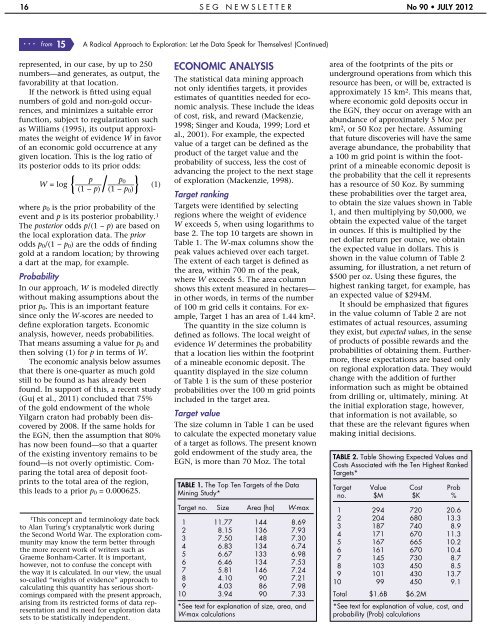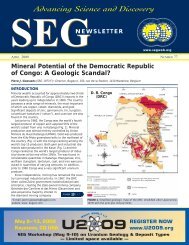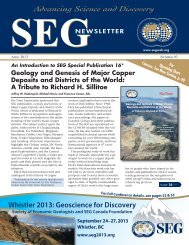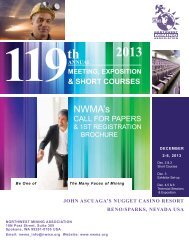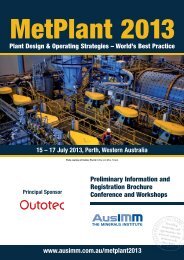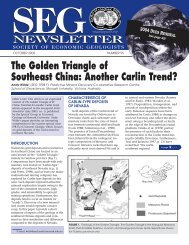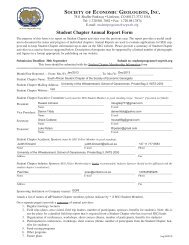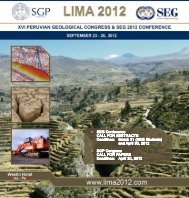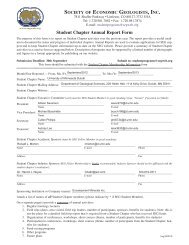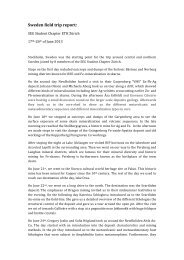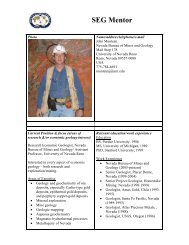SEG - Society of Economic Geologists
SEG - Society of Economic Geologists
SEG - Society of Economic Geologists
Create successful ePaper yourself
Turn your PDF publications into a flip-book with our unique Google optimized e-Paper software.
16 <strong>SEG</strong> NEWSLETTER No 90 • JULY 2012<br />
... from 15<br />
A Radical Approach to Exploration: Let the Data Speak for Themselves! (Continued)<br />
represented, in our case, by up to 250<br />
numbers—and generates, as output, the<br />
favorability at that location.<br />
If the network is fitted using equal<br />
numbers <strong>of</strong> gold and non-gold occurrences,<br />
and minimizes a suitable error<br />
function, subject to regularization such<br />
as Williams (1995), its output approximates<br />
the weight <strong>of</strong> evidence W in favor<br />
<strong>of</strong> an economic gold occurrence at any<br />
given location. This is the log ratio <strong>of</strong><br />
its posterior odds to its prior odds:<br />
p p 0<br />
W = log<br />
{ ———– / ———– }<br />
(1)<br />
(1 − p) (1 − p 0 )<br />
where p 0 is the prior probability <strong>of</strong> the<br />
event and p is its posterior probability. 1<br />
The posterior odds p/(1 − p) are based on<br />
the local exploration data. The prior<br />
odds p 0 /(1 − p 0 ) are the odds <strong>of</strong> finding<br />
gold at a random location; by throwing<br />
a dart at the map, for example.<br />
Probability<br />
In our approach, W is modeled directly<br />
without making assumptions about the<br />
prior p 0 . This is an important feature<br />
since only the W-scores are needed to<br />
define exploration targets. <strong>Economic</strong><br />
analysis, however, needs probabilities.<br />
That means assuming a value for p 0 and<br />
then solving (1) for p in terms <strong>of</strong> W.<br />
The economic analysis below assumes<br />
that there is one-quarter as much gold<br />
still to be found as has already been<br />
found. In support <strong>of</strong> this, a recent study<br />
(Guj et al., 2011) concluded that 75%<br />
<strong>of</strong> the gold endowment <strong>of</strong> the whole<br />
Yilgarn craton had probably been discovered<br />
by 2008. If the same holds for<br />
the EGN, then the assumption that 80%<br />
has now been found—so that a quarter<br />
<strong>of</strong> the existing inventory remains to be<br />
found—is not overly optimistic. Com -<br />
paring the total area <strong>of</strong> deposit footprints<br />
to the total area <strong>of</strong> the region,<br />
this leads to a prior p 0 = 0.000625.<br />
1 This concept and terminology date back<br />
to Alan Turing’s cryptanalytic work during<br />
the Second World War. The exploration community<br />
may know the term better through<br />
the more recent work <strong>of</strong> writers such as<br />
Graeme Bonham-Carter. It is important,<br />
however, not to confuse the concept with<br />
the way it is calculated. In our view, the usual<br />
so-called “weights <strong>of</strong> evidence” approach to<br />
calculating this quantity has serious shortcomings<br />
compared with the present approach,<br />
arising from its restricted forms <strong>of</strong> data representation<br />
and its need for exploration data<br />
sets to be statistically independent.<br />
ECONOMIC ANALYSIS<br />
The statistical data mining approach<br />
not only identifies targets, it provides<br />
estimates <strong>of</strong> quantities needed for economic<br />
analysis. These include the ideas<br />
<strong>of</strong> cost, risk, and reward (Mackenzie,<br />
1998; Singer and Kouda, 1999; Lord et<br />
al., 2001). For example, the expected<br />
value <strong>of</strong> a target can be defined as the<br />
product <strong>of</strong> the target value and the<br />
probability <strong>of</strong> success, less the cost <strong>of</strong><br />
advancing the project to the next stage<br />
<strong>of</strong> exploration (Mackenzie, 1998).<br />
Target ranking<br />
Targets were identified by selecting<br />
regions where the weight <strong>of</strong> evidence<br />
W exceeds 5, when using logarithms to<br />
base 2. The top 10 targets are shown in<br />
Table 1. The W-max columns show the<br />
peak values achieved over each target.<br />
The extent <strong>of</strong> each target is defined as<br />
the area, within 700 m <strong>of</strong> the peak,<br />
where W exceeds 5. The area column<br />
shows this extent measured in hectares—<br />
in other words, in terms <strong>of</strong> the number<br />
<strong>of</strong> 100 m grid cells it contains. For ex -<br />
ample, Target 1 has an area <strong>of</strong> 1.44 km 2 .<br />
The quantity in the size column is<br />
defined as follows. The local weight <strong>of</strong><br />
evidence W determines the probability<br />
that a location lies within the footprint<br />
<strong>of</strong> a mineable economic deposit. The<br />
quantity displayed in the size column<br />
<strong>of</strong> Table 1 is the sum <strong>of</strong> these posterior<br />
probabilities over the 100 m grid points<br />
included in the target area.<br />
Target value<br />
The size column in Table 1 can be used<br />
to calculate the expected monetary value<br />
<strong>of</strong> a target as follows. The present known<br />
gold endowment <strong>of</strong> the study area, the<br />
EGN, is more than 70 Moz. The total<br />
TABLE 1. The Top Ten Targets <strong>of</strong> the Data<br />
Mining Study*<br />
Target no. Size Area (ha) W-max<br />
1 11.77 144 8.69<br />
2 8.15 136 7.93<br />
3 7.50 148 7.30<br />
4 6.83 134 6.74<br />
5 6.67 133 6.98<br />
6 6.46 134 7.53<br />
7 5.81 146 7.24<br />
8 4.10 90 7.21<br />
9 4.03 86 7.98<br />
10 3.94 90 7.33<br />
*See text for explanation <strong>of</strong> size, area, and<br />
W-max calculations<br />
area <strong>of</strong> the footprints <strong>of</strong> the pits or<br />
underground operations from which this<br />
resource has been, or will be, extracted is<br />
approximately 15 km 2 . This means that,<br />
where economic gold deposits occur in<br />
the EGN, they occur on average with an<br />
abundance <strong>of</strong> approximately 5 Moz per<br />
km 2 , or 50 Koz per hectare. Assuming<br />
that future discoveries will have the same<br />
average abundance, the probability that<br />
a 100 m grid point is within the footprint<br />
<strong>of</strong> a mineable economic deposit is<br />
the probability that the cell it represents<br />
has a resource <strong>of</strong> 50 Koz. By summing<br />
these probabilities over the target area,<br />
to obtain the size values shown in Table<br />
1, and then multiplying by 50,000, we<br />
obtain the expected value <strong>of</strong> the target<br />
in ounces. If this is multiplied by the<br />
net dollar return per ounce, we obtain<br />
the expected value in dollars. This is<br />
shown in the value column <strong>of</strong> Table 2<br />
assuming, for illustration, a net return <strong>of</strong><br />
$500 per oz. Using these figures, the<br />
highest ranking target, for example, has<br />
an expected value <strong>of</strong> $294M.<br />
It should be emphasized that figures<br />
in the value column <strong>of</strong> Table 2 are not<br />
estimates <strong>of</strong> actual resources, assuming<br />
they exist, but expected values, in the sense<br />
<strong>of</strong> products <strong>of</strong> possible rewards and the<br />
probabilities <strong>of</strong> obtaining them. Further -<br />
more, these expectations are based only<br />
on regional exploration data. They would<br />
change with the addition <strong>of</strong> further<br />
information such as might be obtained<br />
from drilling or, ultimately, mining. At<br />
the initial exploration stage, however,<br />
that information is not available, so<br />
that these are the relevant figures when<br />
making initial decisions.<br />
TABLE 2. Table Showing Expected Values and<br />
Costs Associated with the Ten Highest Ranked<br />
Targets*<br />
Target Value Cost Prob<br />
no. $M $K %<br />
1 294 720 20.6<br />
2 204 680 13.3<br />
3 187 740 8.9<br />
4 171 670 11.3<br />
5 167 665 10.2<br />
6 161 670 10.4<br />
7 145 730 8.7<br />
8 103 450 8.5<br />
9 101 430 13.7<br />
10 99 450 9.1<br />
Total $1.6B $6.2M<br />
*See text for explanation <strong>of</strong> value, cost, and<br />
probability (Prob) calculations


